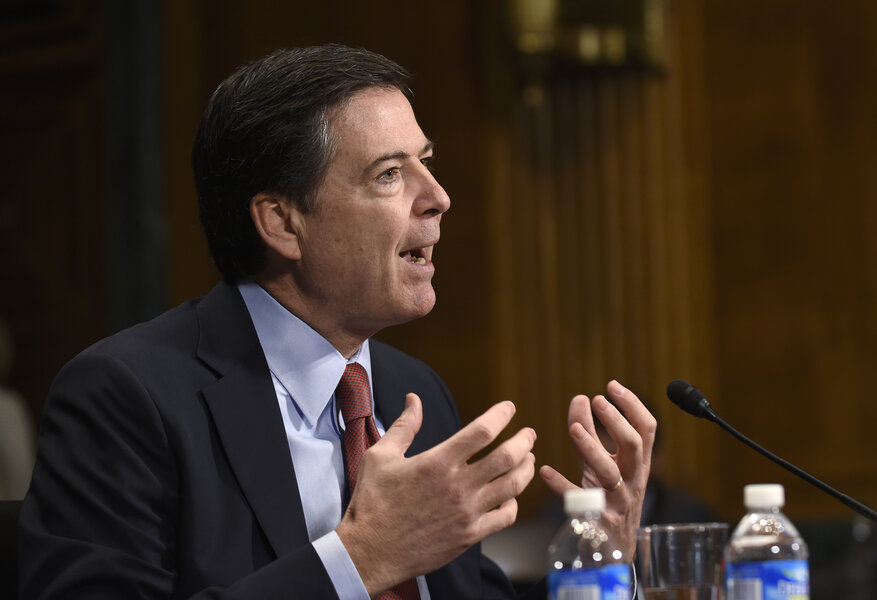FBI: San Bernardino shooters were radicalized at least 2 years ago
Loading...
| WASHINGTON
The two San Bernardino shooters were radicalized at least two years ago — well before one of them came to the U.S. on a fiancée visa — and had discussed jihad and martyrdom as early as 2013, FBI Director James Comey said Wednesday in providing the most specific details to date about the couple's path toward extremism.
Investigators are also looking at whether the husband accused in the shootings was planning an attack in 2012 but abandoned those plans, according to two people familiar with the investigation who were not authorized to discuss the matter publicly and spoke on condition of anonymity.
One week into its investigation, the FBI now believes that Syed Rizwan Farook and his wife, Tashfeen Malik, embraced radical Islamic ideology even before they had begun their online relationship and that Malik held extremist views before she arrived in the U.S. last year, Comey told the Senate Judiciary Committee.
Though the FBI believes the pair was inspired in part by Islamic State ideology — Malik pledged allegiance to the group's leader in a Facebook post around the time of last week's massacre — agents are still looking for other motivations and sources of radicalization, especially because the couple's interest in extremism predates the terror group's emergence as a household name.
"ISIL inspiration may well have been part of this, but these two killers were staring to radicalize towards martyrdom and jihad as early as 2013," said Comey, using an acronym for the Islamic State. "And so that's really before ISIL became the global jihad leader that it is."
The latest disclosure also suggests that the government's vetting process failed to detect Malik's radicalization when she applied for the visa, though Comey said he didn't know enough to say whether weaknesses in the visa process enabled her to enter the U.S.
"After this hearing today, every American will be asking the question, how did this woman come in on a fiancée visa?" said Sen. Chuck Schumer, a New York Democrat and member of the committee.
Malik came to the United States in July 2014 from Pakistan after being approved for a K-1, or fiancée visa, and married Farook the following month. Homeland Security Secretary Jeh Johnson has said the Obama administration is now reviewing the program. He did not say what changes were being considered.
Malik's father, reached in Jiddah, Saudi Arabia, condemned his daughter's actions and said he is "very, very sad. ... I am in such pain that I cannot even describe it."
The father, Gulzar Ahmed Malik, has been a resident in the kingdom since the early 1980s, the Saudi Interior Ministry says. His daughter was from Pakistan but traveled to Saudi Arabia. A former classmate, Afsheen Butt, said Malik showed drastic changes after a trip to Saudi Arabia in late 2008 or early 2009.
Last week's shooting attack at a holiday party killed 14 people and left 21 injured. Former neighbor Enrique Marquez bought the two rifles used in the attack, officials say.
One law enforcement official briefed on the investigation says Marquez has told investigators that he and Farook planned an attack in the United States in 2012 but abandoned the idea. Marquez is a relative of Farook's through marriage. The official says it's unclear what spooked them into cancelling the apparent plot.
Comey described the couple as an example of homegrown violent extremists who appear to have radicalized "in place," drawing a distinction between the San Bernardino attack and the one last month in Paris that officials suspect involved planning and training in Syria. He said the FBI did not yet know if the marriage was arranged by a foreign terrorist organization.
The FBI has revealed little else of what it's learned about Farook and Malik and their planning, except for details about the weaponry they had, materials they had to make more pipe bombs and that both had been taking target practice.
A U.S. official said Tuesday authorities are looking into a deposit made to Farook's bank account before the attack. The official, who had been briefed on the investigation but was not authorized to discuss it by name and spoke on condition of anonymity, would not characterize further the nature of the deposit or why it had caught the attention of investigators. A second official confirmed that the deposit was for $28,500.
Though Comey declined to answer questions about whether encrypted communication had been used before the attack, he did use the appearance to reiterate his longstanding concerns that criminals, terrorists and spies can use encryption applications on their smartphones to evade detection from law enforcement.
"Increasingly, we are unable to see what they say, which gives them a tremendous advantage," he said.
He said one of the gunmen in last May's shooting outside a Prophet Mohammed cartoon contest in Garland, Texas, had exchanged more than 100 messages with an overseas suspected terrorist prior to the attack that investigators still had been unable to access. Investigators were concerned that the location might be targeted, and ensured that law enforcement officers were ready. The two gunmen were shot dead by police.
"We have no idea what he said because those messages were encrypted," Comey said. "And to this day, I can't tell you what he said with that terrorist 109 times the morning of that attack. That is a big problem. We have to grapple with it."
America's counterterrorism infrastructure has had success flagging individuals who try to travel abroad to fight alongside militants, fund operations overseas or who communicate online with overseas terrorists. But it's been far more challenging for law enforcement to identify each individual who self-radicalizes online.
___
Shahzad reported from Islamabad. Alicia A. Caldwell and Tami Abdollah in Washington, Brian Melley in Los Angeles and Asim Tanveer in Multan, Pakistan, contributed to this report.







